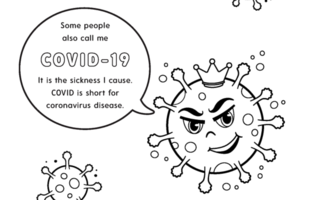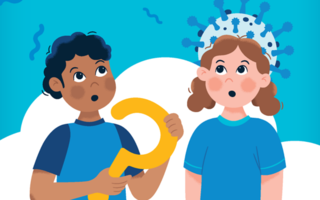Coronavirus Disease 2019
COVID-19 Resources for Parents to Share With Children
A coloring and activity book can help kids better understand COVID-19.
Posted April 28, 2020
COVID-19 has caused countless changes in daily life. While children are incredibly resilient, this can be a bewildering time for the whole family, kids included.
During challenging times, it’s natural to want to protect our children from anything unpleasant, but kids are very observant. Even if it looks like they are not paying attention, they watch their parents and other family members and adults to figure out what is going on.
It’s important to talk openly and honestly with your child. Being open and sharing information can reduce anxiety, confusion, and misconceptions. Children can have active imaginations, which can lead to unnecessary anxiety in times of stress. Because of this, try to find a healthy balance between answering questions openly without overwhelming them with too much information.
St. Jude Children's Research Hospital has created resources for parents to teach their kids about Coronavirus and COVID-19. We've compiled tips on ways to talk about it with children, from young children to teens. I worked with members of my team, including Kristin Canavera, Ph.D. (a psychologist) and Samantha Toohey and Rachel Schmelzer (child life specialists), to develop this content for Together by St. Jude, a resource for anyone affected by childhood cancer. But much of the COVID-19 content could be useful for parents everywhere, as we go through this extraordinary time.
Coloring and Activity Books About Coronavirus and COVID-19
Your child might benefit from a visual explanation to help understand what the novel coronavirus is. It could help them understand, in developmentally appropriate terms, just why we are practicing social distancing. They need to know why it’s so important that we wash our hands, use face masks, and protect ourselves during this pandemic.
The St. Jude psychosocial team has long developed written and visual resources for patients and families to better understand and talk about difficult diagnoses, such as pediatric cancer. Now we have created a suite of coronavirus-related tools including the Learn About the Coronavirus coloring book developed for children ages 5-9, as well as the Learn About the Coronavirus activity book geared toward “tweens” ages 10-13 more or less. St. Jude graphic designer Emily VanGilder illustrated the coronavirus as a character, with a mischievous face that makes it a little more relatable and less scary for kids.
You can download them as PDFs, print them, and share them with your kids.

Tips for Communication With Kids
A very important first step is to talk about what your children already know and check their understanding. Find out what your child has heard and any question he or she might have. With so many sources of information, from the media to friends, it is important to make sure children are getting accurate information.
To start some of these conversations, you may ask:
“Have you heard your friends or other people talking about coronavirus? What are they saying?”
“Do you have questions about coronavirus?”
“What types of things have you heard about coronavirus?”
For younger children, use simple and developmentally appropriate language. For example,
“Have you heard grown-ups talking about a new virus called coronavirus?”
“Have you heard the word ‘COVID-19’? Do you know what it is?”
Prepare yourself with information. If you would like some suggestions for ways to anticipate and answer your child’s questions about coronavirus and COVID-19, here are some child-friendly answers to common questions.
Try to find a healthy balance between answering questions about COVID-19 openly without overwhelming children with too much information.

Find Out What Your Child Is Feeling
Children can have a range of reactions. Some children may be very worried or anxious. Other children may think it is no big deal and not take precautions seriously. It can be helpful to ask about their general feelings as well as how they feel about changes in daily life.
”How do you feel when you hear about coronavirus?”
“How do you feel when you see others wearing masks?”
“What do you think about school being canceled?”
“Is there anything you’re worried about?”
For Little Kids, Play!
Remember that play is the language of children. Play allows for emotional expression and promotes development. For younger children with fewer language skills, play is essential for communication, expression, and overall coping. Use child-friendly ways to make handwashing fun, including singing the ABC song, Happy Birthday, or your child’s favorite song for 20 seconds.
For Teens, Listen!
Sometimes teenagers feel invincible or that risks do not apply to them. You may have noticed your teen not taking the coronavirus seriously. Or they may think everyone is just blowing it out of proportion. Keep in mind that teens may be hearing misinformation from others, especially friends and social media. Engage in conversation with your teen using the suggested prompts, then let them talk. Clarify any misconceptions they may have. Emphasize the importance of using recommended strategies to prevent the spread of coronavirus, such as hand washing and wearing a face covering or mask. Here are some facts about COVID-19 geared toward teens.
Visit Together by St. Jude for even more COVID-19 resources for families, and the CDC website for information on how to protect against COVID-19.




